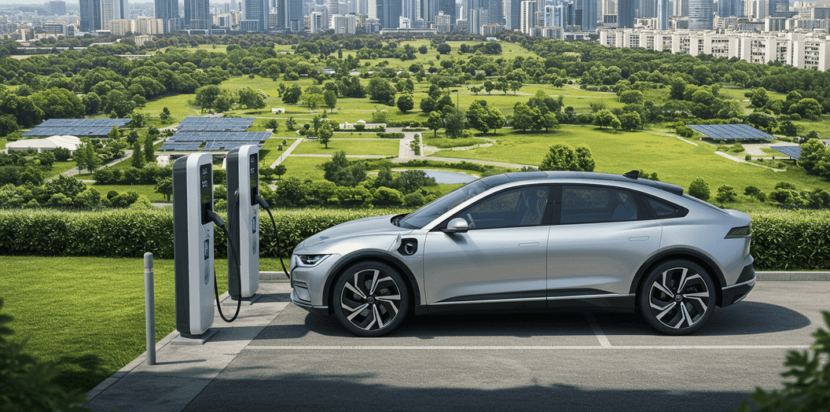The global shift towards sustainable transportation is accelerating, with electric vehicles (EVs) at the forefront of this transformation. As nations and industries strive to meet ambitious climate goals, e-mobility is not just a trend but a necessity. The rise of electric vehicles presents a unique opportunity to significantly reduce greenhouse gas emissions, particularly in the transportation sector, which is one of the largest contributors to global emissions.
However, the transition to e-mobility is not without its challenges. While EVs offer a cleaner alternative to traditional internal combustion engine vehicles, their production, energy consumption, and end-of-life processes also have environmental impacts. This is where carbon credits come into play, offering a mechanism to offset these emissions and incentivize further adoption of clean technologies.
In this article, we will explore how electric vehicles are driving carbon credit opportunities and how businesses can leverage these opportunities to achieve their sustainability goals. We will also discuss the role of QFN-CCC in facilitating this transition and how our e-mobility solutions can help you align with a sustainable future.
1. The Growing Importance of E-Mobility in Carbon Reduction
The transportation sector is responsible for approximately 24% of global CO2 emissions, according to the International Energy Agency (IEA). Traditional vehicles powered by fossil fuels are a major contributor to this, releasing significant amounts of carbon dioxide and other pollutants into the atmosphere.
Electric vehicles offer a promising solution. By replacing gasoline and diesel-powered vehicles with EVs, we can reduce emissions significantly. According to the European Environment Agency, EVs produce about half the emissions of diesel cars over their lifetime, even when accounting for the emissions from electricity generation.
The Role of Carbon Credits in E-Mobility
While EVs are cleaner than traditional vehicles, they are not entirely emission-free. The production of EVs, particularly the extraction of raw materials for batteries, and the electricity used for charging can still result in carbon emissions. This is where carbon credits can play a crucial role.
Carbon credits provide a way to offset the remaining emissions from EVs by investing in projects that reduce or remove carbon from the atmosphere. For instance, a company that operates a fleet of electric vehicles can purchase carbon credits to offset the emissions from the electricity used for charging. This not only helps achieve carbon neutrality but also supports projects that contribute to global sustainability efforts.
Are you looking to reduce the carbon footprint of your vehicle fleet? Explore QFN-CCC’s e-mobility solutions and learn how we can help you offset your emissions with high-quality carbon credits.
2. How E-Mobility is Driving Carbon Credit Opportunities
The rise of e-mobility is creating new opportunities for carbon credit generation. Here are some key ways in which electric vehicles are driving these opportunities:
a. Renewable Energy Integration
One of the most significant carbon credit opportunities arising from e-mobility is the integration of renewable energy sources for charging EVs. By powering electric vehicles with renewable energy, such as solar or wind, the emissions associated with charging can be virtually eliminated.
For example, installing solar panels at EV charging stations can generate carbon credits by reducing the reliance on fossil fuel-based electricity. This not only lowers the carbon footprint of EVs but also supports the growth of renewable energy infrastructure.
b. Battery Recycling and Second-Life Applications
The production and disposal of EV batteries also present carbon credit opportunities. Recycling batteries can reduce the need for raw material extraction, which is energy-intensive and environmentally damaging. Additionally, repurposing used EV batteries for energy storage can provide a second-life application, further reducing their environmental impact.
Carbon credits can be generated by implementing battery recycling programs and establishing second-life battery projects. These initiatives not only contribute to carbon reduction but also promote a circular economy.
c. Fleet Electrification and Charging Infrastructure
Businesses and organizations that transition their vehicle fleets to electric can generate carbon credits through fleet electrification projects. By replacing traditional vehicles with EVs, companies can reduce their emissions and earn carbon credits for the emissions avoided.
Moreover, the development of EV charging infrastructure, such as public charging stations, can also generate carbon credits. By investing in the expansion of charging networks, companies can support the growth of e-mobility and earn credits for the emissions reduced.
Ready to electrify your fleet and earn carbon credits? QFN-CCC offers tailored solutions to help you transition to electric vehicles and maximize your carbon credit potential.
3. The Role of QFN-CCC in Facilitating E-Mobility and Carbon Credit Generation
At QFN-CCC, we understand the complexities of integrating e-mobility into your sustainability strategy. Our team of experts is dedicated to helping businesses navigate the challenges and opportunities of e-mobility and carbon credit generation.
a. Comprehensive Carbon Auditing
We conduct thorough carbon audits to assess the emissions associated with your e-mobility initiatives. By identifying key sources of emissions, we can help you develop effective strategies to reduce your carbon footprint and identify opportunities for carbon credit generation.
b. Project Development and Certification
Our team assists in the design and implementation of e-mobility projects that generate carbon credits. From renewable energy integration to battery recycling and charging infrastructure development, we ensure that your projects meet the standards required for carbon credit certification.
c. Carbon Credit Trading and Portfolio Management
We facilitate the buying and selling of carbon credits, helping you monetize your emissions reductions and optimize your carbon credit portfolio. Our market insights and trading expertise ensure that you get the best value for your carbon credits.
d. Advisory Services and Capacity Building
Our advisory services provide expert guidance on e-mobility and carbon credit strategies. We offer training programs to enhance your team’s understanding of carbon management and sustainability practices, empowering you to make informed decisions and drive your sustainability initiatives forward.
Partner with QFN-CCC and leverage our expertise to maximize the carbon credit potential of your e-mobility initiatives. Contact us today to learn more about our services and how we can support your sustainability goals.
4. Case Studies: E-Mobility and Carbon Credit Success Stories
To illustrate the impact of e-mobility on carbon credit generation, let’s look at some real-world examples:
a. Case Study 1: Fleet Electrification in Europe
A major logistics company in Europe decided to transition its vehicle fleet to electric. By replacing 500 diesel trucks with electric ones, the company reduced its annual emissions by 15,000 tons of CO2. QFN-CCC assisted the company in certifying these emissions reductions, allowing them to generate carbon credits. The company not only achieved significant cost savings on fuel and maintenance but also earned substantial revenue from the sale of carbon credits.
b. Case Study 2: Solar-Powered Charging Stations in North America
A renewable energy company in North America installed solar panels at EV charging stations across the country. By powering the charging stations with solar energy, the company reduced emissions by 5,000 tons of CO2 annually. QFN-CCC helped the company certify these reductions, enabling them to generate carbon credits. The project not only supported the growth of e-mobility but also contributed to the expansion of renewable energy infrastructure.
c. Case Study 3: Battery Recycling Program in Asia
A battery manufacturer in Asia implemented a battery recycling program to reduce the environmental impact of EV batteries. By recycling 10,000 tons of batteries, the company reduced emissions by 2,000 tons of CO2. QFN-CCC assisted the company in certifying these reductions, allowing them to generate carbon credits. The program not only contributed to carbon reduction but also promoted a circular economy.
5. The Future of E-Mobility and Carbon Credits
As the world moves towards a more sustainable future, the role of e-mobility in carbon credit generation is expected to grow. Here are some trends to watch:
a. Increased Adoption of EVs
The global adoption of electric vehicles is projected to increase significantly in the coming years. According to the IEA, the number of EVs on the road could reach 145 million by 2030. This growth will create new opportunities for carbon credit generation as more businesses and individuals transition to electric vehicles.
b. Advancements in Battery Technology
Advancements in battery technology will also play a crucial role in the future of e-mobility and carbon credits. As batteries become more efficient and affordable, the environmental impact of EVs will decrease, creating new avenues for carbon credit opportunities.
c. Expansion of Charging Infrastructure
The expansion of EV charging infrastructure will be another key factor in driving carbon credit opportunities. As more charging stations are installed, the demand for renewable energy integration and energy-efficient technologies will increase, leading to more carbon credit projects.
d. Policy and Regulatory Support
Governments around the world are implementing policies and regulations to support the growth of e-mobility and carbon credit markets. These policies will provide incentives for businesses and individuals to adopt electric vehicles and invest in carbon reduction projects.
Conclusion: Embracing the E-Mobility Revolution
The future of e-mobility is bright, and the opportunities for carbon credit generation are vast. By embracing the e-mobility revolution, businesses can not only reduce their carbon footprint but also contribute to a more sustainable future.
At QFN-CCC, we are committed to helping you navigate this exciting landscape and capitalize on the carbon credit opportunities that come with it. Whether you’re looking to electrify your fleet, integrate renewable energy, or develop innovative carbon reduction projects, we have the expertise and solutions to support your sustainability journey.
Join the e-mobility revolution and unlock the carbon credit potential of your sustainability initiatives. Contact QFN-CCC today to learn more about our e-mobility solutions and how we can help you achieve your carbon reduction goals.

